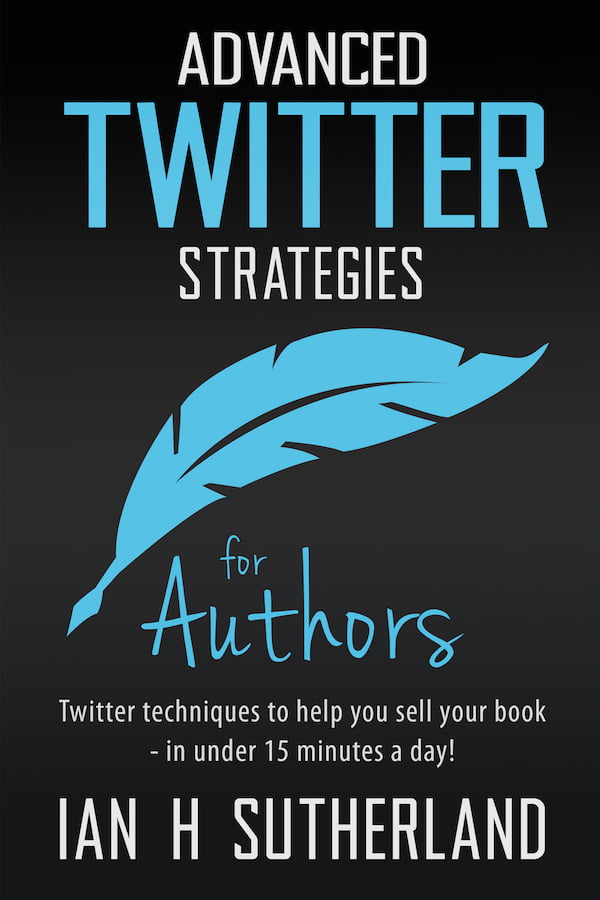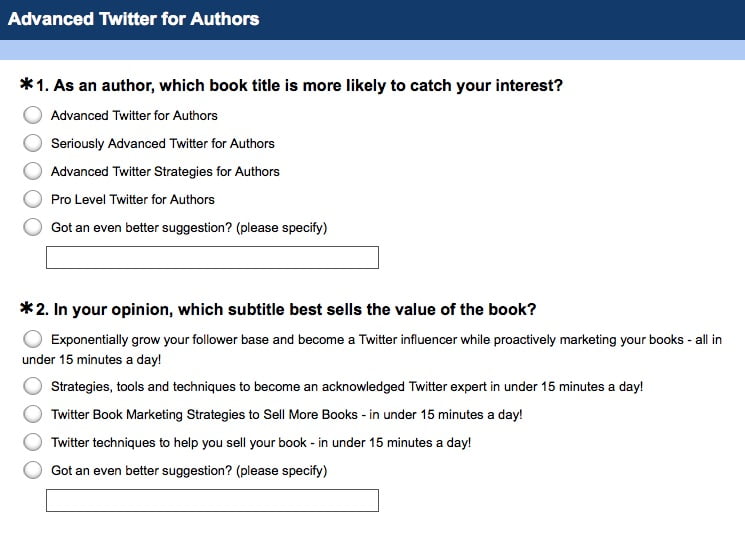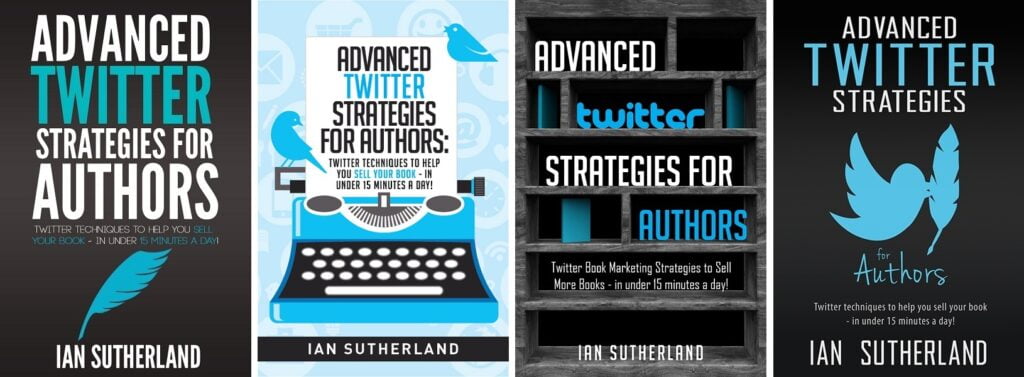One of the many benefits of ALLi membership is access to a closed forum of indie authors around the world, allowing them to ask questions and share answers about best practice in self-publishing away from the public eye. It's a great place to fine-tune ideas pre-launch, and British novelist Ian Sutherland recently shared a survey on the forum to road-test potential cover designs for his new non-fiction book, Advanced Twitter Strategies for Authors. Here he's kindly sharing that experience to help you do the same for your book.
Imagine Ben and Jerry launching a new ice-cream concoction and simply hoping for the best – guessing that the packaging design is enticing, the product descriptions are persuasive and that the texture and flavour within are enjoyable. It's hard to imagine this scenario because most understand that consumer goods companies pour millions into market research, refining the product's design based on feedback prior to eventual launch.
Well, for most indie authors, hope is their strategy: they excitedly press the big button marked ‘publish' and hope for the best. The first real market feedback most authors receive is from readers and reviewers after the book's publication.
But wouldn't it be much better to behave like Ben and Jerry and obtain market feedback pre-publication?
Most indie authors know to use proofreaders or beta readers for the content of their book prior to publication. ALLi has already posted articles on finding and working with beta readers (e.g. Better Your Books with Beta Readers), so I won't cover that here.
For the packaging of your book, however, you can borrow a technique frequently used by the consumer goods companies: surveys.
There are a wide range of survey websites available on the internet. Two of the most popular free-to-use sites are SurveyMonkey and Typeform. Using these, you can set up simple survey questionnaires, asking respondents to vote or provide their opinion on virtually any subject.
Surveys for Your Book’s Title
Many authors build up a list of candidate titles as they write the book. Fiction authors want the punchiest title that goes someway to defining the theme, genre or emotions of the novel. Non-fiction authors need the title that best sells the promise of what the book will teach the reader or help them understand better.
By using a survey tool, you can obtain feedback on your shortlist of titles, helping you narrow down on the best one. Set up a multiple choice survey in your chosen survey website and then promote it on your website, your email list and on social media. When people click on the link you provide, it will take them to the online survey and they can give you feedback.
If you already have an active readership, using surveys in this way is yet another way for you to further your two-way engagement with readers and, at the same time, subtly market your upcoming release.
Let me share an example from my own recent experience. I was writing a non-fiction book on using Twitter, aimed other authors. I’d come up with a shortlist of potential high hitting titles and subtitles. I designed a simple questionnaire in SurveyMonkey. The first page gave them the context, explaining why I was looking for their feedback and presented the draft blurb for the book, title omitted. The second page contained two multiple choice questions. Here are the two questions:
The most popular title and subtitle was chosen by over 50% of responders. As a result, the book is now called Advanced Twitter Strategies for Authors: Twitter techniques to help you sell your book – in under 15 minutes a day!
Of course, at this moment, prior to publication, no one really knows if it’s the best choice. But, having carried out this level of market research, I’m fairly confident that it’s the title that will attract the majority of people in my target market.
Surveys for Your Book’s Cover Design
Often, when an author works with a cover designer, there may be different cover design drafts to choose between. Who better than your target readership to give you feedback on which cover catches their eye the best?
It became quickly apparent that the fourth design above hit the mark with most people. What was particularly interesting, was that the second design, which I quite liked, polarised opinion completely. People either loved it or hated it.
I was also saved from making a major faux pas. The winning design had re-purposed Twitter's famous bird logo. Thankfully, some well-informed survey responders pointed out that I would be in violation of Twitter's brand usage rules. Thanks to market research, I saved myself this embarrassment and any redesign costs. I fed this information back to the designer and the end result was even stronger:
This is the final cover design with the final title and subtitle, all elements thoroughly market tested and ready for launch on April 14th, 2015. Like Ben and Jerry, I'm now much more confident that the packaging of the product is appealing to the majority of people in its target market (and it's already available on Amazon to pre-order).
Now, where did I put the names of those proofreaders to validate the content?
(You'll find Ian on Twitter at @IanSuth)
OVER TO YOU
Have you tried Ian's method to home in on the right cover? How do you choose yours? Share your experience via the comments box!
EASY TWEET
When is a book cover like a @BenandJerrys ice cream? Read @IanSuth's post on cover design to find out! #selfpub #AuthorALLi Share on X







[…] Read Ian’s Author Advice article about “How to use a survey to choose a book cover”… […]
[…] Production Tips: How To Use a Survey to Choose A Book Cover Novelist Ian Sutherland shares tips on how he used a survey to choose a book cover. […]
Love this article. I’m a huge proponent of crowd-sourcing. Why stop at the cover? Even the content within can be crowdsourced. And what’s better, when the book goes to print (or e-ink), those that helped you write will also help you promote/sell it!
Thanks for the feedback and the recommendation of Pickfu. It does look very good, although I don’t think there is a free mode though, which is where I focused for the article. Hope you enjoy the Twitter book when it comes out!
Hi, Ian. Great design! I love that it is easy to read in the small version, which is how most buyers will see it online.
I had to laugh when you mentioned that your favorite didn’t win. Mine NEVER does. In fact, I am now convinced that whatever I think will work is definitely the wrong approach! This is why I love 99Designs and the polling feature.
As for titles/subtitles, you can also use a service like Pickfu.com. The demographic info from respondents will help you sort which votes match your market. I’ve used this for subtitling books and choosing book covers.
Selling is different from writing, and as indies we have to do the market research to make sure we’re resonating with our audience – especially when it comes to areas in which most of us are not professionals, like design and marketing. Using surveys is a great way to do it!
And since I’m horrible at using Twitter, I think I should buy your new book! 🙂
Ian – thanks for the post… Superb timing… I’m meeting my cover designer this evening and then over the weekend I’m launching a survey on some potential book covers! I intend to show 3 covers and ask what they think each one is telling them about the book.
A while ago I ran a survey to get feedback on some possible titles. I asked how much they thought each title would catch their eye, then gave a little bit of blurb and asked if that changed their mind about the titles. Finally I asked them how much they read this genre and most importantly they had to type in the titles they could remember. The results were fascinating – broadly speaking the ones they thought would catch their eye were the ones they couldn’t remember and vice versa. This led me to create a subtitle from one of the titles and it became Fluence: ten thousand minutes and counting.